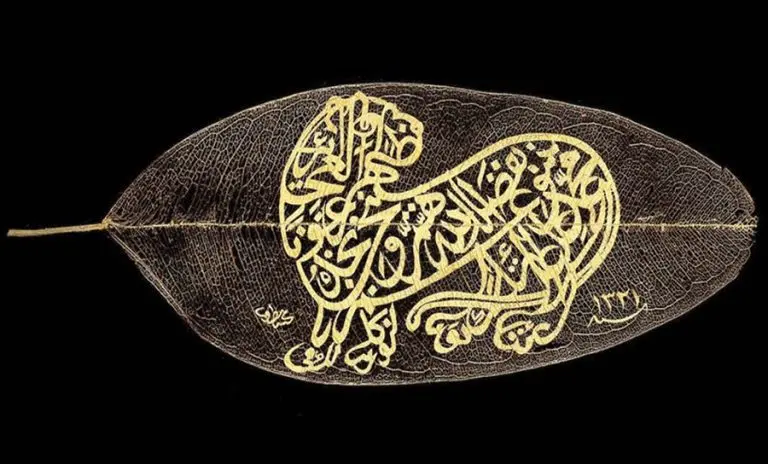On its own, calligraphy is already an intricate craft that takes months or even years to master. So, rendering it on a delicate canvas would only mean doubling the effort and the difficulty. Well, apparently, calligraphers in Ottoman Turkey were up for this challenge as they created enchanting leaf calligraphy that showcases the complexity and versatility of the Arabic language.
Online art platform Bayt Al Fann recently took to their Twitter page to share exquisite examples of this magnificent technique. Each piece features a swooping Arabic script in gold that pops against a translucent dried leaf. The coarse pattern of the leaf veins and the elegant flourishes of the script create a charming contrast that gives the piece more visual interest.
The art of calligraphy on a dried leaf, was practised widely in Ottoman Turkey. This was difficult & delicate work. The leaf was dried, & the tissue removed to leave the skeletal membrane, with gold ink applied over it.
For Ramadan, here are 20 exquisite examples…
A thread… pic.twitter.com/i2ltfhY6gs
— Bayt Al Fann (@BaytAlFann) April 19, 2022
12/ Calligraphy Leaf
Ottoman Turkey
19th centuryArabic composition applied onto a natural leaf in gold.#Ramadan pic.twitter.com/liHAMJ21I6
— Bayt Al Fann (@BaytAlFann) April 19, 2022
5/ Calligraphy Leaf
Ottoman Turkey
19th centuryTo apply the calligraphy the stencil of the composition is placed behind the leaf and the gold ink with gum Arabic is applied.@MIAQatar #Ramadan pic.twitter.com/DOe2RqSuRd
— Bayt Al Fann (@BaytAlFann) April 19, 2022
4/ Calligraphy Leaf
Ottoman Turkey
19th centuryArabic composition applied on to a natural leaf in gold, the text in the form of a lion incorporating verses praising the Imam ‘Ali by al-Sherif al-Murtaza#Ramadan pic.twitter.com/17jmnURV7D
— Bayt Al Fann (@BaytAlFann) April 19, 2022
This enchanting leaf calligraphy technique by the Ottoman Turks showcases the complexity and versatility of the Arabic language
Singapore’s Asian Civilisations Museum is home to an extensive collection of these alluring calligraphic compositions on leaves. According to the museum, this elevated art form rose to prominence particularly in Ottoman Turkey during the 19th century.
4/ Calligraphy Leaf
Ottoman Turkey
19th centuryArabic composition applied on to a natural leaf in gold, the text in the form of a lion incorporating verses praising the Imam ‘Ali by al-Sherif al-Murtaza#Ramadan pic.twitter.com/17jmnURV7D
— Bayt Al Fann (@BaytAlFann) April 19, 2022
9/ Calligraphy Leaf
Ottoman Turkey
19th centuryArabic composition applied onto a natural leaf in gold, the text incorporating the words Allah, Angels, the Prophets, the Day of Judgment in the form of a sailing boat with seven oars, one for each of the Seven Sleepers#Ramadan pic.twitter.com/ebVhDbVyve
— Bayt Al Fann (@BaytAlFann) April 19, 2022
8/ Calligraphy Leaf
Ottoman Turkey
19th centuryArabic composition applied onto a natural leaf in gold, the text incorporating the Bismallah and invocations to God and the Prophet Muhammad (PBUH) within a stylised Sufi cap#Ramadan pic.twitter.com/CYu8cLTk7b
— Bayt Al Fann (@BaytAlFann) April 19, 2022
Following the indispensable role of religion at the time, Quran verses, prayers, and poetry were popular theme choices for most calligraphers
To take their compositions to the next level, some calligraphers even produced scripts that took the shape of animals, fruits, and other objects like ships and vases. Needlessly to say, this technique requires great attention to detail and mastery of the craft.
“The leaf has to be dried, and the tissue has to be removed slowly so as to leave the skeletal membrane. The stencil of the composition is placed behind the leaf and the gold ink with gum Arabic is applied over it.”
15/ Calligraphy Leaf
Ottoman Turkey
19th centuryArabic composition applied in the shape of a vase onto a natural leaf, the text from the Qur’an, surat al-Ahzab, chapter XXXIII, verse 23#Ramadan pic.twitter.com/2ptWmcfMqs
— Bayt Al Fann (@BaytAlFann) April 19, 2022
6/ Calligraphy Leaf
Ottoman Turkey
19th centuryIn the form of a stork, the text comprising a Sufi verse, signed Abd al-Ghani and with date AH 1311/AD 1893#Ramadan pic.twitter.com/0xfFYJ6fT2
— Bayt Al Fann (@BaytAlFann) April 19, 2022
18/ Calligraphy Leaf
Ottoman Turkey
19th centuryArabic composition gold calligraphy applied onto a natural tree leaf in gold.#Ramadan pic.twitter.com/nKkKs9uaEO
— Bayt Al Fann (@BaytAlFann) April 19, 2022
Check out the entire thread to see more of these stunning dazzling pieces, and feel free to follow Bayt Al Fann to learn more about Islamic art and culture.
Source: Bayt Al Fann Twitter | Website

